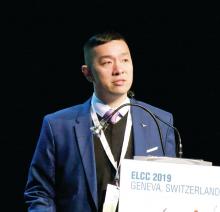GENEVA – The TRK inhibitor larotrectinib is highly active in lung cancer patients with NTRK gene fusions, supporting routine screening for such fusions in cases of lung cancer, according to investigators.
Although NTRK fusions are relatively infrequent in lung cancer, lead author Alexander Drilon, MD, of Memorial Sloan Kettering Cancer Center, New York, suggested that their low frequency should not preclude testing in the current diagnostic setting.
“The frequency of TRK fusions in lung cancers in a prospective series that we put together was at the order of 0.23%, recognizing that the paradigm now for molecular profiling in lung cancer screens for many different drivers together, and not just single-gene testing,” Dr. Drilon said at the European Lung Cancer Conference. Dr. Drilon noted that larotrectinib is now approved by the Food and Drug Administration for the treatment of adult and pediatric patients with TRK fusion-positive cancers.
The present analysis involved 11 patients with metastatic lung adenocarcinoma and NTRK gene fusions from two previous clinical trials (NCT02122913 and NCT02576431); of these patients, 8 had NTRK1 fusions and 3 had NTRK3 fusions. Patients were given larotrectinib 100 mg twice daily on a continuous 28-day schedule until disease progression, unacceptable toxicity, or withdrawal. Almost all patients (10 out of 11) had a prior systemic therapy, and 5 patients had three or more prior therapies. The best response to previous therapies included four stable disease and one partial response. Out of 11 patients, 4 were ineligible for response analysis because of a treatment period of less than 1 month, leaving 7 evaluable patients; of these, 2 patients had stable disease, 4 had a partial response, and 1 had a complete response, translating to an overall response rate of 71%. On average, patients responded in just 1.8 months, with responses ranging from 7.4 months to 17.6 months, with the caveat that median duration of response has yet to be met. Treatment was generally well tolerated, with most adverse events being grade 1 or 2. Dr. Drilon cited a historical dose reduction rate of 9% and a discontinuation rate of less than 1% (out of 122 patients across cancer types).
Although most patients were heavily pretreated, Dr. Drilon highlighted one patient, a 76-year-old woman with non–small cell lung cancer, who had an NTRK1 gene fusion and multiple metastases to the brain and contralateral lung. This patient received larotrectinib as first-line therapy after refusing standard platinum doublet chemotherapy. The woman had a partial response, including “a near complete intracranial response with 95% volumetric shrinkage,” Dr. Drilon said at the meeting, presented by the European Society for Medical Oncology. “She remains on therapy as of six and a half months per the last data cutoff and is still doing well without any substantial toxicities from this drug.”
“In conclusion, larotrectinib is active in advanced lung cancers that harbor a TRK fusion,” Dr. Drilon said. “Of course, these [findings] underscore the utility of molecular profiling for TRK fusions when we look for drivers in patients with non–small cell lung cancer.”
When asked by the invited discussant if NTRK fusions should be tested up-front in all cases of non–small cell lung cancer, Dr. Drilon said, “I think the answer is absolutely yes.” He highlighted the fact that this study and other existing research has shown an overall response rate of about 70%, “which certainly beats the outcomes that we see with other systemic therapies, including, arguably, chemoimmunotherapy for this population. So I think that the paradigm here should be similar to the paradigm for EGFR and ALK, where we have an active target therapeutic that we can use up front, which would likely really improve outcomes for patients.”
Loxo Oncology Inc. and Bayer AG funded the study. The investigators reported financial relationships with Ignyta, Loxo, TP Therapeutics, AstraZeneca, Pfizer, and others.
SOURCE: Drilon et al. ELCC 2019. Abstract 111O.


